How far to plant grapes?
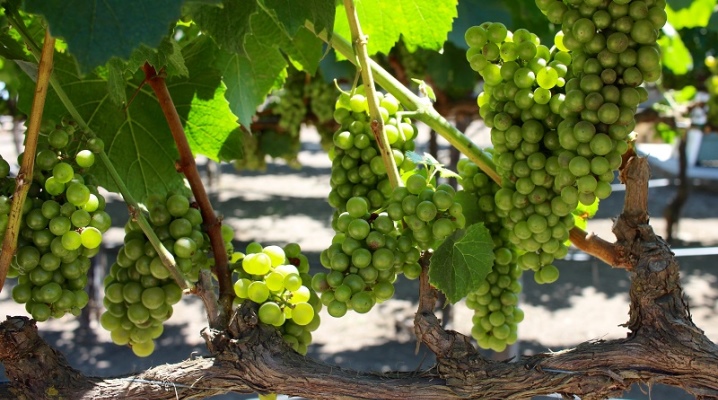
To obtain a high-quality grape harvest, certain conditions must be created for the fruit plant. Gardeners adhere to a predetermined irrigation schedule, temperature and other factors. It is also important to maintain the correct distance between shrubs. A suitable planting scheme will allow the plant to develop comfortably and care will be as convenient as possible.
It is necessary to determine a suitable planting scheme before planting a vineyard, since replanting fruit plants will be problematic and undesirable. The choice of distance is influenced by many factors, taking into account which you can achieve regular fruiting.
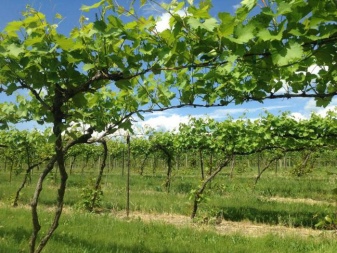
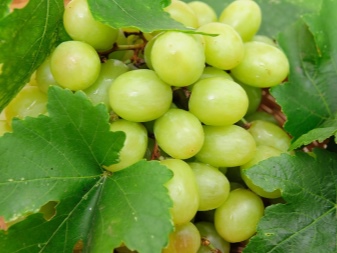
Influencing factors
Despite the fact that grapes are considered a viable and unpretentious crop, they need optimal growing conditions.
When choosing a suitable growing scheme, gardeners take into account a number of criteria.
- The type of growth of the variety and the structure of the plant. Allocate tall, medium-sized and undersized varieties. The structure of the bush can be sprawling or compact.
- Climate on the territory of the region of cultivation.
- Composition and structure of the soil.
- Pollination method indicated in the description for each variety. The vine can grow female, male, or self-fertile flowers. More space is left between self-pollinated varieties than between cross-pollinated varieties.
- Support option (using).
- Number of seedlings.
- The ripening time of the crop.
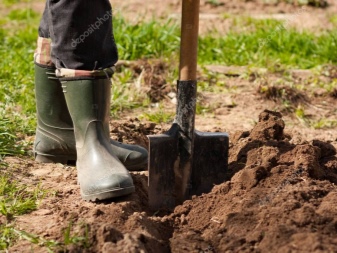
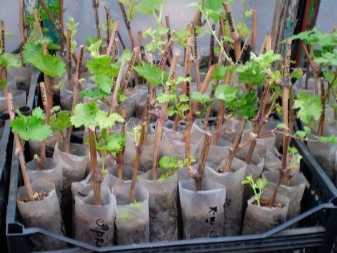
The distance between plants is due to the following factors:
- the needs of a particular variety for lighting, the amount of nutrients and space;
- the possibility of maximum thickening of the planting without loss of yield.
Experienced summer residents consider the above characteristics to be mutually exclusive, and when drawing up a planting scheme, a compromise must be sought. The main thing is to take into account the basic requirements of the variety for the cultivation conditions. The distance between shrubs affects the yield of the fruit crop. Many gardeners without experience plant too thick, wanting to get the maximum berries from one square meter, but as a result, fruiting only worsened.
If the plants were planted too close to each other, you need to thin out the vine regularly to free up as much free space as possible. Too dense plant mass will interfere with the sun's rays from warming the berries, and oxygen exchange will be disrupted.

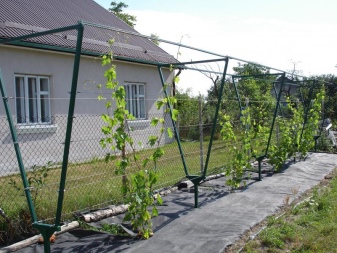
Traditional scheme
There is a standard landing design option.
- Planting pit diameter - 0.5 meters, the depth varies from 30 to 40 centimeters.
- Place in each hole irrigation tube.
- Drainage layer thickness - from 10 to 15 centimeters... Broken bricks, rubble, or small stones can be used.
- A layer of fertile soil is poured over itthat was dug from the planting pit. If the land on the site is heavy, it is mixed with a small amount of sand. A peg is driven in here.
- A gap of 1.5-3 meters is left between the bushes. depending on the splendor of the bush.
- The planting hole is filled to the brim with the remaining soil. A young plant is watered with plenty of water. To preserve moisture and protect against weeds, a layer of mulch from organic raw materials (sawdust, needles, chips and other options) is laid on top.
Note: Grapes are planted in autumn or spring, depending on the climate in the region.
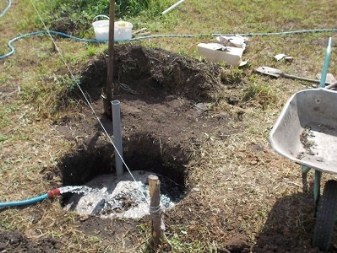
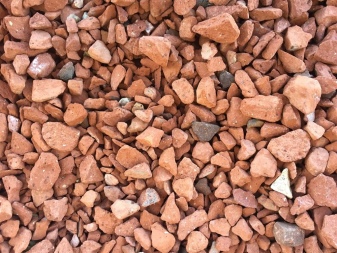
Optimal options
It is necessary to plant grapes at such a distance from each other so that each plant is comfortable throughout the growing season.
Between the bushes
With the size of the free space between the shrubs, it is necessary to take into account the growth rate, the ripening time of berries, the volume of vegetation and the splendor of the crown. Low-growing grapes are planted at a distance of 1.5-2 meters, for medium-sized varieties, a gap of 2-3 meters is left, and for spreading varieties, three or more meters of space are left. This distance between the vines will not only ensure a stable yield, but also prevent fungal infections and other diseases. Often, fruit crops begin to ache due to a planting that is too thickened.
Early varieties are pruned regularly to save site space. In these varieties, shoots continue to grow even after harvesting. This feature is absent in late grapes. Experienced gardeners recommend paying attention for the need of each variety for natural lighting.
For example, white grapes need a metered amount of light, and with an excess of it, the berries become sour. But red varieties love a lot of light. It is necessary for the ripening of a juicy and tasty harvest.
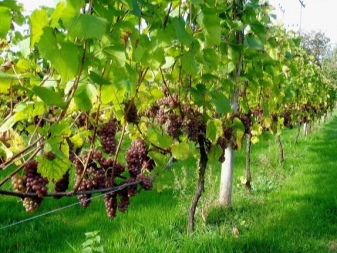
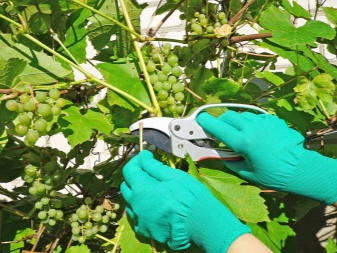
Between the rows
The choice of a suitable row spacing is influenced by the following:
- the use of mechanization means that will be used when caring for the grapes; for their passage, you need to leave enough space so as not to damage the vine;
- the gap between plants in adjacent rows;
- vineyard configuration;
- illumination.
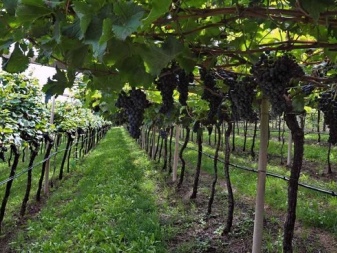
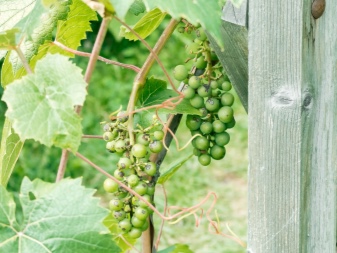
The main criterion is the distance between plants. If in one row it counts from 3 to 3.5 meters, then the breakdown in the row spacing should be the same. Otherwise, the shrubs will remain too close in the transverse direction. It is believed that the rows can be arranged more closely when installing a two-row trellis. In many cases, this planting pattern is available and will work for most grape varieties.
The next important point is the direction of the rows for each grade. For white grapes, a perpendicular arrangement to the incidence of sunlight is ideal, but bushes of red grapes are planted parallel to the direction of light. Thus, it will be possible to create optimal conditions for achieving high taste and the development of bunches.
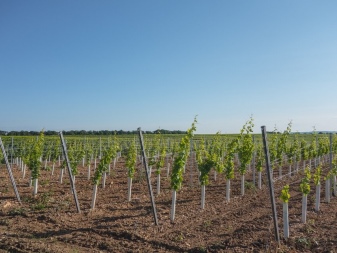
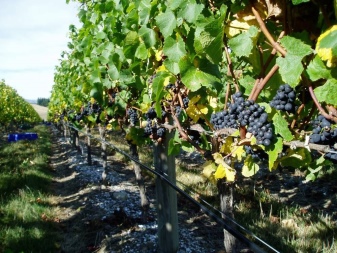
For trellises
Trellis are often used in most horticultural crops. With the help of the supports, you can comfortably position a long vine. When calculating the distance between the rows, the type of trellis is taken into account. When using a single-plane scheme, up to 2 meters of space is left, while the fruit crop is processed manually. Two-plane options are also widely used. The gap between the rows is calculated from the upper edge of the support. When manually processing shrubs, the distance is left at 2 meters, and when using mechanized garden equipment - from 3 to 4 meters.
To achieve better illumination, gardeners make sure that the branches that are attached to the trellis are at a distance of 10-20 centimeters... And you should also take into account the spreading and height of the crown. Grafted grapes require an increased amount of nutrients compared to native rooted species. The structure of the root system is not disregarded either. In some varieties, the roots are deep and go far into the ground, while in others they are located in the upper layers of the earth. The arrangement of the used trellises affects the illumination. It can be corrected by changing the distance between bushes.


Tables were compiled indicating the distance between plants, taking into account the root system of the plant and the type of trellis installed.
Single-strip trellis:
- own-rooted grapes - distance from 2.5 to 3 meters;
- the same types of shrubs, but with drip irrigation system - distance from 3 to 3.5 meters;
- grafted grapes - the gap between the bushes is left the same (3-3.5 meters);
- grafted plants with drip irrigation system - from 3.5 to 4 meters.
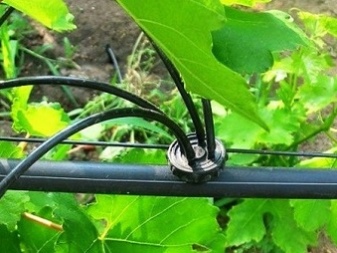
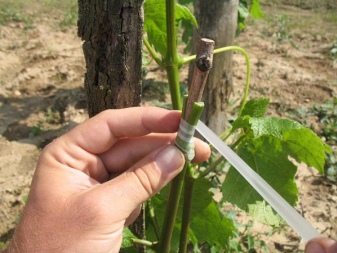
Scheme for two-plane trellis;
- shrubs with their own root system - from one and a half to 2 meters;
- own-rooted grapes, which is watered using a drip system - from 1.8 to 2.5 meters;
- grafted fruit crops - from 1.8 to 2.5 meters;
- grafted grapes with drip irrigation - from 2.5 to 3 meters.
In compiling this table, gardeners used the standard distance between the vines, which varies from 10-15 centimeters to 20-25 centimeters.
The maximum yield can be achieved by calculating the optimal number of shoots. Shrubs should have enough strength to form not only green mass, but also large clusters.
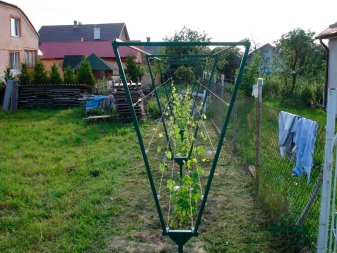

For industrial grades
When growing a fruit crop on an industrial scale, large plantings should be made. To care for a large vineyard, special drip irrigation systems are installed. They will regularly moisturize the shrubs and maintain the desired moisture level in the soil. And also install single-plane trellis. When growing, it is not complete without the use of specialized fertilizers. The required amount of nutrients will ensure the formation of a juicy, tasty and aromatic crop.
To save space on the site, you can leave a gap of one and a half meters between the plants, and at least three meters should be left between the rows so that all agricultural machinery can drive freely.
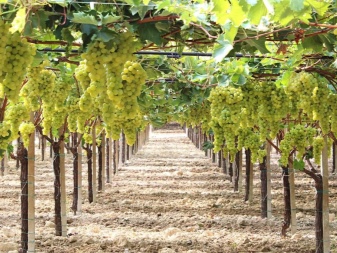
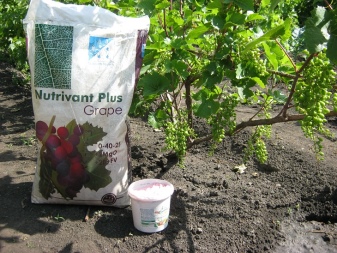
Greenhouse planting distance
Within the northern regions, grapes are often planted in greenhouses, especially when growing thermophilic varieties. Some varieties do not tolerate low temperatures well and may even die. Greenhouses will help create comfortable conditions for shrubs and protect them from the vagaries of the weather. Additional light sources and heating devices can be installed in them to maintain a comfortable temperature regime.
The dimensions of modern greenhouses do not always allow observing the recommended planting schemes, but special greenhouse conditions make it possible to reduce the distance without harming the plants. Nutrition, lighting and watering are artificial and controlled, so slight thickening is quite acceptable. Here, drip irrigation systems and ultraviolet lights are most often used. In greenhouse cultivation, up to 2 meters are left between the rows, while the shrubs are planted at a distance of one and a half meters. This planting scheme is chosen by many gardeners throughout Russia.
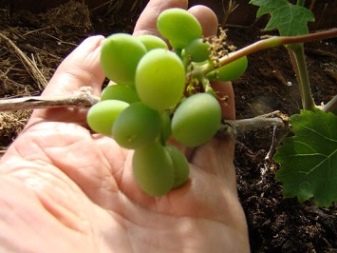
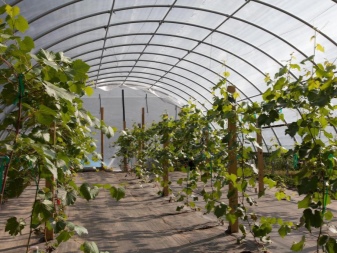
For information on how far to plant grapes, see the next video.













The comment was sent successfully.